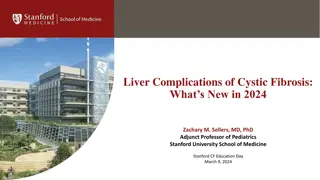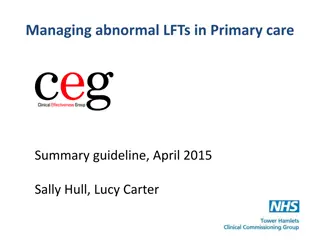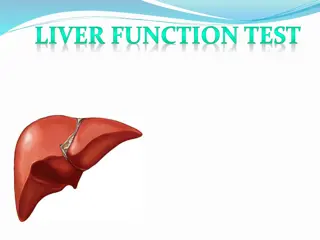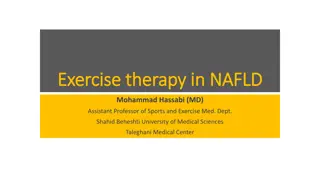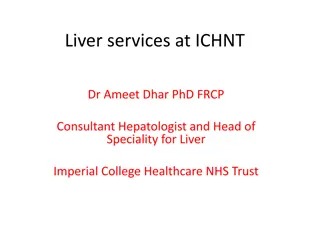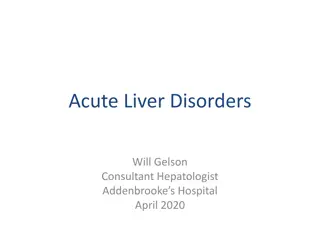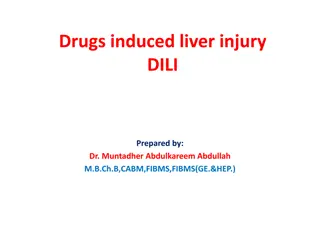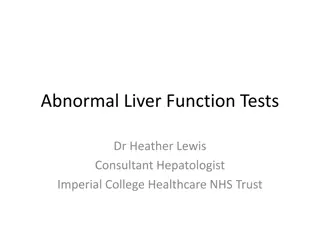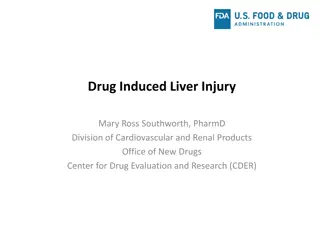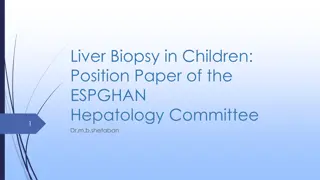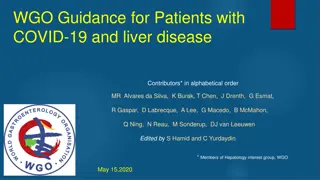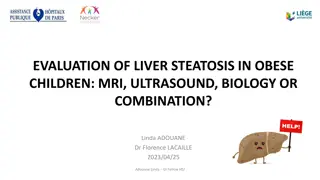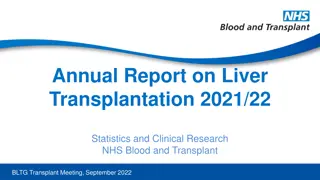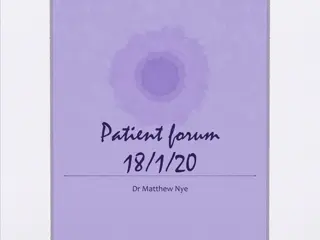Prediction of Liver Fibrosis in NAFLD Patients: Impact of CAP Values
Steatosis has emerged as a significant diagnosis with NAFLD becoming a common cause for hepatologic evaluation. Liver stiffness measurement (LSM) using transient elastography is vital for assessing fibrosis severity in NAFLD patients. However, the accuracy of LSM can be influenced by obesity and severity of steatosis. A new non-invasive test, the Controlled Attenuation Parameter (CAP), offers quantitative data on liver fat content through ultrasound wave attenuation quantification. This study aimed to investigate the association between CAP values and LSM in predicting liver fibrosis in NAFLD patients from various cohorts across Europe and Asia.
Download Presentation

Please find below an Image/Link to download the presentation.
The content on the website is provided AS IS for your information and personal use only. It may not be sold, licensed, or shared on other websites without obtaining consent from the author. Download presentation by click this link. If you encounter any issues during the download, it is possible that the publisher has removed the file from their server.
E N D
Presentation Transcript
JOURNAL CLUB Bern December 6th, 2017 Dr. Rosangela Piccinni
Background Why steatosis has become a relevant diagnosis : NAFLD per s has become the most frequent cause for hepatologic evaluation: NASH was recentely identified as an important cause of cirrhosis and HCC; steatosis/NAFLD is an important co-factor of progression in all CLD.
Background-2 One of the main issue to verify the prognosis of NAFLD patients is the evaluation of liver fibrosis severity Liver stiffness measurement by transient elastography is a noninvasive tool that can replace liver biopsy
Background-3 Liver stiffness measurement sufficiently accurate to predict fibrosis stage in NAFLD patients Wong et al, Hepatology 2010 BUT its diagnostic performance is affected by obesity and severity of steatosis (increasing the rates of false positive results) Petta et al, Hepatology 2015
Background-4 A new test for fatty liver: controlled attenuation parameter (CAP) New non invasive parameter able to provide quantitative and numerical data regarding liver fat content through the quantification of attenuation of ultrasound waves Berzigotti, J Hepatology 2014 CAP quantifies US attenuation in the liver at the central frequency of the probe. CAP is numerically expressed in dB/m (100 to 400 dB/m)
Aim of the study They wanted to determine whether prediction of liver fibrosis by LSM in NAFLD patients is affected by CAP values
Patients and methods Consecutive patients from 4 prospective cohorts (3 European centers, 1 Asian) Patients with biopsy-proven NAFLD with reliable LSM and CAP EXCLUSION CRITERIA: advanced cirrhosis; HCC; other causes of liver disease; HIV; Immunosuppressive drugs and/or steatosis-inducing drugs Active intravenous drug addiction or use of cannabis
Patients and methods-2 LIVER STIFFNESS MEASUREMENT LSM and CAP were assessed on the same day as liver biopsy All the LSM were classified into 3 categories: - very reliable: IQR/M<=0.10 -reliable: 0.10<IQR/M<=0.30 -poorly reliable: IQR/M>0.30
Patients and methods-3 HISTOLOGICAL ASSESSMENT A minimum 15-mm-long-biopsy specimen or At least 10 complete portal tracts Steatosis assessed as the percentage of hepatocytes containing fat droplets Kleiner classification staging fibrosis NASH= steatosis+lobular inflammation+ ballooning
Results factors associated with CAP Higher CAP values were significantly associated with CAP IQR, BMI and steatosis
Results factors associated with LSM Entire cohort: LSM independently linked to higher CAP values, higher LSM IQR values and fibrosis
Results factors associated with LSM The independent association between LSM and CAP is confirmed in F0-F2 fibrosis but not in F3-F4
Results Impact of CAP on LSM values and on accuracy of TE for staging fibrosis 8.5 kPa: F2-F4 (AUC 0.808, Se 74.3%, Sp 73.7%) 10.1 kPa: F3-F4 (AUC 0.861, Se 77.6%, Sp 78.4%)
Results Impact of CAP on LSM values When patients were considered at each fibrosis stage, lower grades of fibrosis only, values progressively increased from lower to the middle further to the higher tertiles for LSM the and CAP
Results Impact of CAP on LSM values and on accuracy of TE for staging fibrosis Rate of false-positive LSM results for the diagnosis of F2-F4 fibrosis increased from the lower CAP tertile to the higher tertiles Similar differences in false positive LSM results for the diagnosis of F3-F4 fibrosis were observed
Results Impact of CAP on LSM values and on accuracy of TE for staging fibrosis A diagnostic flowchart for the correct interpretation of LSM values according to CAP values was designed for the diagnosis of F2-F4 and F3-F4 fibrosis
Discussion CAP is independently linked to increased LSM values, especially in patients with lower stages of fibrosis Higher rates of false positive LSM in patients in the higher CAP tertiles Importance of a correct interpretation of LSM values according to CAP
Discussion -2 8.5 kPa and 10.1 kPa are the best cutoffs for discriminating F2-F4 and F3-F4 fibrosis, respectively
Limitations Interobserver concordance of LSM and CAP examinations as well as of liver histological readings were not assessed; Analysis of LSM was carried out using a conventional M probe only Study cohort population: NAFLD subject referred to tertiary center Lack of follow up
Conclusion LSM in NAFLD may lead to overstimation of fibrosis in patients with lower stages of disease. interpreting LSM values based on determination of CAP could help to more accurately use TE for predicting fibrosis in NAFLD
Controlled Attenuation Parameter reflects intrahepatic fat content in patients with compensated advanced chronic liver disease * Baveno VI, 2015 What it is known: overweight/obesity and histologically steatosis are predictors of clinical decompensation in cACLD* Berzigotti et al. Hepatology 2011 Everhart et al. Gastroenterology 2009 What it is unknow: Does CAP in cACLD correctly mirror hepatic fat content?
Controlled Attenuation Parameter reflects intrahepatic fat content in patients with compensated advanced chronic liver disease Aims: To assess the accuracy of CAP for steatosis in patients with cACLD of any cause To validate CAP IQR < 40 dB/m as good quality criterion in reducing errors
Controlled Attenuation Parameter reflects intrahepatic fat content in patients with compensated advanced chronic liver disease Aims: To assess the accuracy of CAP for steatosis in patients with cACLD of any cause To validate CAP IQR < 40 dB/m as good quality criterion in reducing errors
Controlled Attenuation Parameter reflects intrahepatic fat content in patients with compensated advanced chronic liver disease Inclusion criteria: Patients with liver biopsy CAP measurement avaiable LSM 10 kPa Methods: Single center retrospective study 6/2015-6/2017 Exclusion criteria: LSM< 10 kPa Any hepatic decompensation No LSM/CAP avaiable in 6 mo. LSM IQR/M>30 M or XL probe were used as appropriate On histology: steatosis: S0 (<5%), S1 (5-33%) S2 (33-66%), S3 (>66%) fibrosis F3 (metavir or equivalent) to confirm ACLD
Controlled Attenuation Parameter reflects intrahepatic fat content in patients with compensated advanced chronic liver disease 461 biopsies for liver disease No LS/CAP available= 161 LS <10kPa=141 Decompensation =12 aCLD= 147 No valid LS/CAP measurements (IQR/M)>30 = 18 Timelapse betweenm biopsy and CAP >6 months = 5 Study cohort population=124
Controlled Attenuation Parameter reflects intrahepatic fat content in patients with compensated advanced chronic liver disease Results: 124 patients BMI median 27.4 LS median 16.3 (10-75) CAP median 272 (0-400) IQR <40 60% NAFLD/NASH 30.5% etiology of liver disease alcohol+metabolic/viral+metabolic 15.2% viral 15.2% autoimmune 7.2% alcohol 4.2% others 12.4%
Controlled Attenuation Parameter reflects intrahepatic fat content in patients with compensated advanced chronic liver disease Results: Study cohort population Steatosis on LB 69.4% S1 33.9% Almost exclusively seen in patients with NAFLD/NASH or metabolic syndrome+alc ohol/viral disease S2 19.4% S3 16.1%
Controlled Attenuation Parameter reflects intrahepatic fat content in patients with compensated advanced chronic liver disease Results: bridging fibrosis/cirrhosis on histology (73 pt) Steatosis on LB 75% S2-S3 36%
Controlled Attenuation Parameter reflects intrahepatic fat content in patients with compensated advanced chronic liver disease Results: CAP accuracy in entire population any steatosis 0.827 (0.746-0.908) p<0.0001 S2-S3 steatosis 0.864 (0.796-0.93) p<0.0001 CAP accuracy in bridging fibrosis/cirrhosis on histology (73 pt) any steatosis 0.766 (0.631-0.900) P=0.001 S2-S3 steatosis 0.828 (0.727-0.930) p<0.001
Controlled Attenuation Parameter reflects intrahepatic fat content in patients with compensated advanced chronic liver disease Results: CAP and IQR IQR 40 dB/m IQR < 40 dB/m any steatosis 0.675 0.781 S2-S3 steatosis 0.675 0.799
Controlled Attenuation Parameter reflects intrahepatic fat content in patients with compensated advanced chronic liver disease Conclusion: Steatosis is very frequent in patients with histologically confirmed advanced fibrosis and cirrhosis and clinical features of metabolic syndrome CAP discriminative ability in this specific population is fair for steatosis and good for steatosis S2-S3 CAP IQR 40 dB/m should be considered an indicator of lower diagnostic accuracy in this setting



